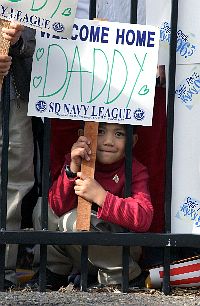
The Source for Navy News
VS-35 Returns Home
Story Number: NNS030718-14
Release Date: 7/18/2003 9:15:00 PM
By Journalist 2nd Class Rebecca Horton, Navy Region Southwest Public Affairs
SAN DIEGO (NNS) -- May 3 marked the return for San Diego-based ‘Blue Wolves’ of Sea Control Squadron (VS) 35 from a nearly 10-month deployment.
Assigned to Carrier Air Wing 14 aboard USS Abraham Lincoln (CVN 72), the Blue Wolves conducted missions in support of Operations Enduring Freedom, Southern Watch and Iraqi Freedom during their extended deployment.
“The squadron flew 2,139 sorties throughout the entire cruise, with 404 of those during Operation Iraqi Freedom,” said Lt. Cmdr. Scott Zellem, VS-35 department head. “We logged more than 4,600 hours of flight time with 877 hours taking place during OIF [Operation Iraqi Freedom].”
The Blue Wolves squadron, consisting of eight S-3B Viking aircraft, 11 pilots and 19 naval flight officers, passed nearly 2 million pounds of fuel throughout the cruise and an additional 1.2 million pounds during OIF.
In January, the Abraham Lincoln Strike Group was on its way home when it received orders to turn around and head back to the Arabian Gulf.
“I was ready,” said Aircraft Mechanic 3rd Class David Bash, “and so were all my fellow airdales the day our commander gave us the news that we were turning around and heading back. Every Sailor in VS-35 felt prepared and ready for OIF," said Zellem.
“Our performance during work-ups, Operation Enduring Freedom, and Operation Southern Watch proved that we were capable of handling any situation,” said Lt. j.g. Vanessa “Silent Bob” Melofchik, a naval flight officer and co-pilot tactical coordinator in the S-3B Viking. “The saying ‘practice how you play’ is the best way to describe it. We practiced our mission during work-ups and perfected it during other operations. When the war came, it was time to play, and we were ready.”
“Operation Southern Watch consisted mostly of Surface Surveillance and Control (SSC) flights, which required a thorough search of all sea space surrounding the carrier strike group,” said Zellem. SSC flights usually take place at low altitudes (between 1,000 and 5,000 feet) while the aircrew conducts a radar search of the area. Then they drop to lower altitudes (200 to 500 feet) if they are investigating any unknown surface contacts (ships or submarines) that require a visual description or photographs to be taken.
Along with SSC flights, VS-35 provided continuous Recovery Tanking for the entire air wing. That meant they could provide fuel to other airborne aircraft if they were having trouble landing aboard the ship and were running low on fuel.
“Our aircraft have very efficient engines, so we were always launching 15 minutes before everyone else and landing after all the other tankable aircraft have recovered on board the ship,” said Zellem. “We also provided sporadic Mission Tanking - basically extra fuel for the F/A-18 Hornets to conduct some of their more high performance training. At times, we provided the service of dropping ‘smokes’ or floating sea markers to use as targets when dropping practice bombs out in the middle of the ocean,” said Zellem.
“We provided both front side and back side fuel for the F/A-18s, F-14 Tomcats and sometimes the Super Hornet and the EA-6B Prowlers,” said Zellem. “We would rendezvous with them at various places in the northern Arabian Gulf or over Kuwait, provide fuel for them to complete their missions into Iraq and then have a separate wave of S-3s waiting for the strikers to come back from their mission to refuel them again, so they would have enough fuel to make it back to the carrier and land.
“Often, towards the end of OIF, the strikers were coming out of Iraq at extremely low fuel states. We would be waiting just over the water ‘feet wet’ just south of the border of Iraq to join on the strikers, give them gas and escort them back to the carrier. While doing these ‘Mission Tanking’ or Aerial Refueling missions, we would still have one or two aircraft with extra gas overhead the carrier as a back up for aircraft landing - the Recovery Tanker missions.”
Each of these flights launched with ordnance in the Viking’s bomb bay (the belly of the aircraft) in support of possible surface threats in the region.
“The aircrew knew that we could not fail in our mission,” said Lt. Matt “T-Bone” Delabarre, an S-3B Viking pilot. “We routinely flew in weather that would have grounded other aircraft to ensure that the gas was in the right place at the right time."
“We all feel incredibly lucky being able to come home to our families and friends,” said Zellem. “We are proud to serve our country and are glad that we could do the job we were asked to do, and that we didn’t let our country down. Our thoughts and prayers are with our fallen comrades from this conflict and those who are still in the field of battle.”
For related news, visit the Navy Region Southwest Navy NewsStand page at www.news.navy.mil/local/cnrsw.
E-mail this story to a friend | Send a comment about this story
Two Lincoln Sailors Excited to See Fellow Hometown Resident - 5/5/2003Operation Instant Wedding - 7/7/2003
|
All Any Exact |
|
